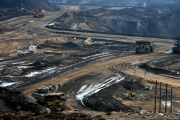During the 1990s, humans took 63 billion tonnes of carbon from the earth's crust and put it in the air as carbon dioxide (CO2). Only half of that CO2 was reabsorbed by oceans and forests. For millennia the atmospheric concentration of CO2 hovered around 280 parts per million (ppm). By 2003, we had pushed it to 376 ppm, a level probably unprecedented in 20 million years.
We're altering not only the atmosphere's composition, but the amount of the sun's energy it absorbs. CO2 is a heat-trapping greenhouse gas (GHG). Unless we cut emissions sharply, climate zones are going to shift, species disappear, ice melt, and sea level rise. The costs — environmental, human and financial — will be huge.
The excessive burning of carbon-based fossil fuels — coal, gasoline, other oil products and natural gas — is the principal cause. To stabilize the atmospheric concentration of CO2 at a safe level and prevent the worst effects of climate change, we need to cut emissions from fossil fuels by well over 50 per cent.
Time is short. Paths to stabilization of the CO2 concentration at 550 ppm start to diverge sharply from paths to stabilization at 1000 ppm around the year 2012. A CO2 concentration of 1000 ppm is likely to lead to very damaging impacts. Government bodies including the European Union and prominent CO2-emitting companies like BP have concluded that stabilization must be achieved at 550 ppm or lower.
What do we need to do to get there? Increasing energy use by growing economies creates tremendous upwards pressure on CO2 emissions. Even allowing for technological innovation, business-as-usual is clearly not going to take us where we need to go. Governments must intervene. Here are some key steps:
Agree to a series of near-term, legally binding emissions targets. Some people complain that the timeframe for the Kyoto targets (2008-12) is too short. But the political reality is that without the Kyoto Protocol, the need to cut emissions would be nowhere near its present high level on governments' agendas. Governments must continue to face tough near-term targets under international law.
Adopt integrated energy and climate policies including long-term emissions targets. Incredibly, given that most emissions result from energy use, energy policy is still commonly discussed separately from climate policy. The U.K. set an important counter example in its Energy White Paper, which included a goal to cut CO2 emissions by 60 per cent by 2050.
Legislate caps on industrial emissions. Over half the GHG emissions in a country like Canada come from industrial facilities. Governments can control these emissions in a business- and innovation-friendly way by fixing an overall cap, but allowing emissions trading under the cap. The European Union's version of such a system will begin operating in January.
Use regulated standards and financial incentives to boost energy efficiency and renewable energy. There is tremendous potential for increasing the efficiency of products like vehicles, buildings and appliances. Uptake of efficient technologies can be boosted through financial incentives, while inefficient technologies are eliminated by regulation. Numerous jurisdictions in the US and Europe are boosting renewable energy by combining production incentives and regulated quotas.
Ensure clean urban development. Our cities need to be more liveable, with a far smaller environmental footprint. By requiring higher-density development and improving public transit, governments can drive major reductions in GHG emissions.
Take tough enough action to persuade developing countries to join in. GHG emissions from developing countries remain low on a per capita basis but are rising fast. And businesses that compete in global markets want to see emission constraints imposed globally. But countries like China and India are not going to accept constraints if the developed world is not seriously cutting its own emissions.
How is Canada faring against this checklist? Not well. We've taken an important first step by ratifying the Kyoto Protocol, but we have no GHG target beyond 2012 and no national energy strategy. De facto energy policy is encouraging sustained long-term increases in emissions from Alberta's oilsands.
The federal government has developed legislation to create a system of mandatory emissions targets for large industry, but has not yet introduced it in Parliament. A voluntary approach is still being pursued for vehicle efficiency, while key energy regulations like building codes are years out of date. More positively, serious provincial and federal measures to boost renewable energy are underway. But our public transit systems languish far below European standards.
Overall, Canada's GHG emissions are 20 per cent higher than they were in 1990 and still increasing. A step change in our efforts is needed if we are to do our fair share to stabilize the atmosphere.
This op-ed appeared as part of the Globe and Mail's supplement on climate change, Global Warning, on December 17, 2004. Read the entire supplement.






